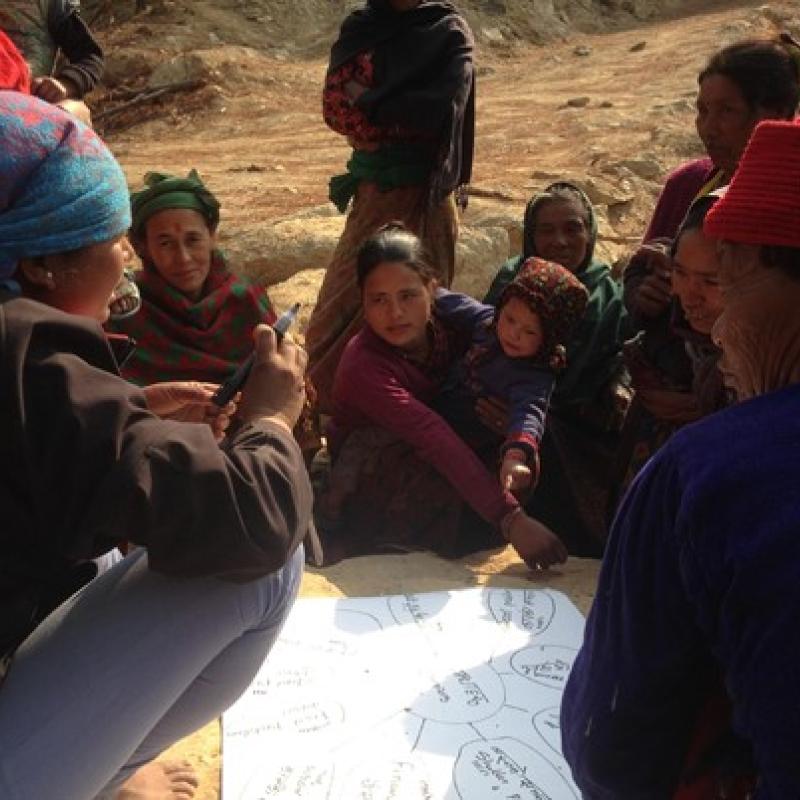Co-creating safety measures in Nepal for better and safer housing

Nepal is one of the poorest countries and affected by multi-hazard risks, including earthquakes, landslides and floods. We invite you to help make houses and settlements safer and better in Nepal for earthquakes and floods by finding out what assistance is most effective! For this study, you can build upon the extensive network we have in Nepal via our faculty and the earlier research we have done. For this study, you have the opportunity to go to our partners in Nepal for 2-3 months. Alternatively, you can decide to work from the Netherlands.
Personalize assistance
Every situation and every person is different. It is not effective to give everyone the same assistance. Currently, there are no governmental or humanitarian reconstruction assistance approaches that are personalized to the situation, motivations, abilities, and opportunities of individual households at risk. In this challenge, we aim to develop a method to adapt reconstruction assistance to individuals. We focus on multi-hazard situations in which people reconstruct or repair their house. How can they effectively be helped to make informed construction decisions?
Learn from vernacular building methods and spatial plans
Often building codes and spatial plans are developed without engagement of these communities. However, the introduction of new building codes and spatial plans might require another way of living and land use. Therefore, communities should be granted possibilities to co-create the building code and spatial plans. The best ideas might not come from the capital but from the people how have a long-lived experience dealing with the hazards. It is a challenge to bring those ideas from the communities to the governmental decision makers.
Co-create resilience strategies
To enhance resilience, we can learn from existing co-creation strategies to develop a method for effective engagement of people in spatial policy making and housing designs. This method should facilitate governmental and humanitarian stakeholders in Nepal their interaction with communities living in the flood prone or earthquake affected areas.
Potential supervisors
- Dr. Eefje Hendriks,e.hendriks@utwente.nl Assistant professor, Disaster Resilience and Humanitarian Assistance
- Dr. Alberto Martinetti a.martinetti@utwente.nl Associate Professor in the chair of Maintenance Engineering within the department of Design, Production and Management.
Advisors
- Dr. Mia Stokmans, M.J.W.Stokmans@tilburguniversity.edu Associate Professor, Tilburg School of Humanities and Digital Sciences, Department of Culture Studies, University of Tilburg.
- Dr. Rupesh Shrestha Rupesh.Shrestha@crs.org (Catholic Relief Services Nepal)
- Dr. Inu Pradhan Salike inupradhan@gmail.com (Tribhuvan University, Institute of Engineering(IOE)
- Dr. Sanjay Upreti, suprety@ioe.edu.np (Tribhuvan University, Institute of Engineering(IOE)
We are looking forward to working with you and you have the liberty to select the topics that have your main interest. We are interested in the main research question: What are effective ways to co-develop spatial plans and building methods in flood-prone and earthquake prone rural communities in Nepal?
- Study and evaluate theories about co-creating methods for construction methods and/or spatial plans. Interview researchers with extensive experience in the analysis and development of effective assistance strategies.
- Interview humanitarian and governmental actors about their professional experience with community engagement and analyze their suggestions.
- Point out differences and commonalities in the scientific and practical strategies and evaluate their importance for different spatial dimensions, such as varying flood and earthquake risks. Evaluate the different engagement strategies on criteria such as effectiveness, inclusion, participation.
- Study empirical data. You can use data that we have collected in an earthquake affected area and in a flood affected area to better understand current decision making. How does that align with the strategies you have found?
- Use the Strategic Targeted Intervention Design method to connect household decision making (their motivation, ability, and opportunity to improve the safety of their house) to the design of effective interventions.
- Design an engagement strategy or method for Nepal in close collaboration with local partners. Specify adaptability of the method to individuals and communities in multi-hazard situations.
- Craterre. (2015), Assessing Local Building Cultures for Resilience & Development: A Practical Guide for Community-Based Assessment. https://sheltercluster.org/fiji-cyclone-winston-2016/documents/assessing-local-building-cultures-practical-guide-community
- Hendriks, E. and Opdyke, A. (2022), 'The influence of technical assistance and funding on perceptions of post-disaster housing safety after the 2015 Gorkha earthquakes in Nepal', International Journal of Disaster Risk Reduction, Elsevier Ltd, Vol. 73, https://doi.org/10.1016/j.ijdrr.2022.102906.
- Hendriks, E., Schep, B. and van Leersum, A. (2021), 'The influence of technical assistance on the adoption of safer construction practices in Nepal', Enhancing Disaster Preparedness, Elsevier, pp. 59–81, https://doi.org/10.1016/B978-0-12-819078-4.00004-6.
- Hendriks, E. and Stokmans, M. (2020), 'Drivers and barriers for the adoption of hazard-resistant construction knowledge in Nepal: Applying the motivation, ability, opportunity (MAO) theory', International Journal of Disaster Risk Reduction, Elsevier Ltd, Vol. 51, https://doi.org/10.1016/j.ijdrr.2020.101778
- Hendriks, E., Stokmans, M. Developing strategic targeted interaction design to enhance disaster resilience of vulnerable communities. Nat Hazards (2023). https://doi.org/10.1007/s11069-023-06224-2
- IFRC. (2011), PASSA Participatory Approach for Safe Shelter Awareness, Geneva. https://www.ifrc.org/ifrc/document/passa-participatory-approach-safe-shelter-awareness
- Interaction and USAID. (2019), The Wider Impacts of Humanitariabn Shelter and Settlement Assistance -Key Findings Report. https://www.humanitarianlibrary.org/resource/wider-impacts-humanitarian-shelter-and-settlements-assistance-key-findings-report
- Turnbull, M., Sterrett, C. l., Hirano, S. and Hilleboe, A. (2015), Extending Impact: Factors Influencing Households to Adopt Hazard-Resistant Construction Practices in Post-Disaster Settings, Baltimore, Maryland. https://www.crs.org/our-work-overseas/research-publications/extending-impact
